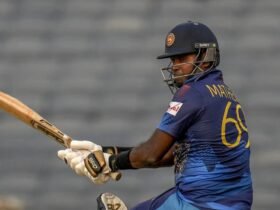Some Rules of Cricket
- Cricket is not difficult to play, and it is also very easy to understand, there are 5 main components of cricket, which include ball, bat, wicket, stump, bails. And only in relation to these there are relations of cricket.
- 11 players play in cricket and in this two teams play against each other. Both have 11-11 players. In which one fielding and the other team batting. Which team will bat or field is selected by toss.
- There are 11 players in a cricket team, out of which one is a wicketkeeper, some are bowlers and some are batsmen.
- This game is mainly played in a circular shaped field, and this field is also quite large, because in this game long fours and sixes are hit. Those who go very far, so the field needs to be a little bigger.
- There is a pitch in the middle of the field, on which batting is done, in which it is in the shape of a long quadrilateral. In this, there is three stumps with 2-2 bails on both of the stumps, which is used to stop the batsmen.
- The process of throwing the ball in this game of cricket is called delivery. And when 6 balls are bowled it is considered an over. Similarly, many games are of 20 overs, and many games are of 50 overs.
- A test match is of 5 days and 90 overs are played every day. While playing the match, two players of the team which is batting are present in the cricket ground. And the players who are fielding, 11 of their players are present on the ground, which are 11 players of the fielding team. One of the players is the bowler, one is the wicket-keeper, the wicket-keeper stands behind the player who is batting and moves towards the wicket.
Some rules and regulations of fielding
It is the responsibility of the fielding team to play the game of cricket properly, do not use any dirty technique to win the match-
- While fielding, there is a wicket keeper and a bowler, although all 11 players are expert in batting, wicket keeping and bowling. But still some players have some special arts. A bowler is good at bowling. Batsmen are good at batting. And an all-rounder is good at both bowling and batting. A wicket keeper is good at wicket keeping
- Only two players stand between the square leg and the long stop fielding position in a cricket field.
- In the first 10 overs of the match, only 2 players can come in the circle of 30 yards.
- Between 11 and 40 overs, 3 players can come in the circle of 30 yards.
- In the last 10 overs of 50 overs, 5 players can be brought in the circle of 30 yards.
- There are some balls in cricket that do not count, such as no ball, dead ball, wide ball, etc.
- No ball occurs when a bowler crosses the line on the crease with his front foot. A distance is fixed from which a bowler can bowl a batsman.
- If a batsman breaks that distance, then even if the batsman is out by the ball bowled at that time, then he is not called out. Rather he has to bowl that ball from the back. And even if the batsman is out on that next ball, then he cannot be considered out. This is how the penalty ball is called.
- Free hit is given after every no ball.
- A dead ball is said to be a dead ball when a ball hits the pitch twice while traveling from the ball to the middle of the batsman, then that ball is called a dead ball.
- There is no free hit after the dead ball, but the bowler has to bowl a new ball again.
- A wide ball is called a wide ball when a bowler puts his ball outside the batsman’s hitting area, then that ball is called a wide ball. And when the wide ball is bowled, the batsman gets 1 run and 1 ball.
How To Score Runs
There are many ways to score runs in cricket-
- First is the method in which if a batsman hits the ball, he must return the ball to that batsman’s hand or till it is in the hand of the wicketkeeper, if the batsman completes the middle of the wicket from one wicket to the other. If he runs then it is called 1 run.
- There is a boundary on the entire ground which is a fixed boundary. And if a batsman reaches that ball near that boundary, then he gets a surprise six.
- There are 2 ways to reach the boundary, firstly by rolling the ball off the ground and secondly by going into the air.
- If a batsman hits the ball across the boundary while rolling it off the ground, then he gets 4 runs and if a batsman hits the ball hard and reaches it through the air after that boundary, then he gets 6 runs. But while hitting hard, if the ball stops somewhere before the boundary, then he gets only 4 runs.
- Apart from this, the batsman also gets 1 run above the night ball.
- Apart from this, if the bowler does not bowl according to the rules of bowling, then the batsman gets extra runs for this.
Some rules for the batsman
- A batsman can bat till he is out. And there are some ways for a batsman to get out, which include Catch Out, Bold, Hit Wicket, Stump Out, Leg Before Wicket, Run Out.
- When a batsman throws the ball into the air to hit a six or four, and the ball falls into the air just before the boundary, and if a fielder catches the ball before the fall, the batsman is caught out. It happens. There are many ways to catch today.
- If a batsman is batting and the bowler has bowled him such a fast ball that the ball strikes the lanes of the wicket before the batsman understands anything, then the batsman is bowled.
- If the bowler delivers a ball to the batsman in whom the ball strikes any part of the batsman’s body in the direction where the wicket is, ie the stumps, the batsman is out by leg before the wicket, and is considered out.
- If the batsman is outside the line of the wicket while batting, and the ball hits the wicket with or without touching the batsman or the wicketkeeper catches the ball and hits the stumps and the bails fall down. The batsman is considered out and this process is called stump out.
- If the batsman is running between the two wickets to score runs, and while running, the ball comes into the hands of the bowler or the wicketkeeper or if the ball hits the lanes of the stump, then the wicketkeeper is considered run out.
These are some of the rules that come in handy while batting, while bowling and while fielding. And if a person and a player play cricket knowing these rules, then playing cricket becomes a little easier for him, and it becomes easier to understand.




























Leave a Reply